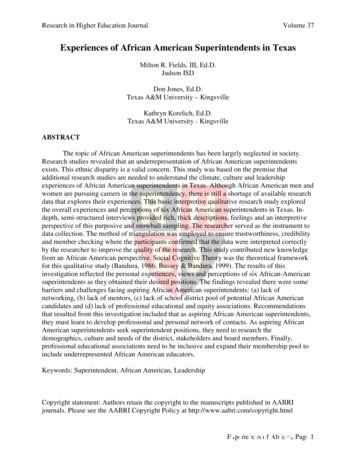Learning African American History - UMS
2017-18UMS LEARNING GUIDEImmersion:ExploringAfrican-AmericanHistory In Ypsilanti2017——18BE PRESENTSaturday, March 3, 20188:00 am – 6:00 pmVarious locations in and around YpsilantiBE PRESENT1
Table of Contents0308THE IMMERSIONYPSILANTI, MICHIGAN03040507081011121314Foreword: Framing the dayOverviewPresentersImmersion Agenda15RESOURCESHistory of Ypsilanti16 Organizations and InformationA.P. Marshall17 Ann Arbor District LibraryRiverside Arts CenterLandmark Ypsilanti Tour HighlightsYpsilanti African American Mural ProjectBrown African Methodist Episcopal Church18CONNECT18 About UMS19 Sponsors and Credits
LEARNForeword: Framing Your DayTERRI PARKUMS EDUCATION COORDINATORWhy is it important tostudy history? Studyinghistory can help usunderstand the past.Studying history canhelp us understand thepresent. Studying historycan help us connect toour own culture. Studyinghistory can provideinsight to cultureswith which we are lessfamiliar, even though theymay be close to home.This is where I foundmyself when I beganmy research for thisseason’s K-12 culturalimmersion. I was amazed to discover the rich history of African-Americanheritage right next door in Ypsilanti. Like many of us, as a young child Ilearned about slavery, the Civil War, and the heroic acts of Harriet Tubmanin school. But I did not really connect with African-American history in asignificant, meaningful, and impactful way.Thus my educational journey began. I looked at old maps of Ypsilantifarmland. Black and white photos of the Second Baptist Church andDepot Town. Photos of African-American soldiers who fought in the CivilWar and the dozens of unnamed Black Americans that worked hard toestablish businesses, churches, and a community where they could liveand thrive.I read news articles about slaves who escaped to Canada travelingthrough Ypsilanti. I read clippings on Ypsilanti’s rich social life andmusic scene. I read numerous articles about local political activismduring Jim Crow. This history had faces and landmarks and seemednot so distant and disconnected. Though I will never truly know thesuffering and hardship that African Americans endured — and stillendure today — I hope to be a better ally as I now more fully appreciatethat learning about Black history is learning about American history —and local history.People have come to our nation and our community from many countriesin the world, and to have a complete account of American history wemust include all of their stories. Our shared history is inherently multicultural — a tapestry of tales, stories of the strong, of the powerless,of Blacks, whites, and immigrants. While we may not always share thesame viewpoints, I believe that with a deeper understanding of oneanother’s stories, we can more effectively move forward as one family.Photo: 1868 Bird’s-eye map of Ypsilanti-Ypsilanti Historical Society.BE PRESENT3
THE IMMERSIONOverviewThis day-long immersion explores the rich African-American history ofYpsilanti, Michigan. UMS is partnering with community artists, scholars, andlong-time residents to guide participants through a series of immersivehistoric, cultural, and artistic experiences.Participants will visit important historical sites, including places thatserved as safe houses on the Underground Railroad, the resting placesof Ypsilanti’s African-American Civil War veterans from the 102nd Troop(an African-American infantry unit of the Union Army), neighborhoodsthat were important sites during the civil rights era, as well as many otherlandmarks representing the rich, longstanding history and culture of AfricanAmericans in Michigan. Workshops will feature artistic demonstrations andresources that can be brought back into the classroom.Immersions are day-long, intensive workshops that focus on a specificculture, community, or art form. They are designed in partnership with localand national experts and are connected to UMS season programming.BE P
immersion. I was amazed to discover the rich history of African-American heritage right next door in Ypsilanti. Like many of us, as a young child I learned about slavery, the Civil War, and the heroic acts of Harriet Tubman in school. But I did not really connect with African-American history
African-Americans in the Early Twentieth Century 1895-1928 Third Written Paper on African American Writing Assignment due April 9 by 11:50 p.m. Week 11: The African-American Odyssey 17. African Americans and the 1920s 1918-1929 Week 12: The African-American Odyssey 18. Black Protest, the Grea
Sep 21, 2015 · AFRICAN AND AFRICAN AMERICAN CULTURAL UNITY DAY IN HONOR OF BLACK HISTORY MONTH, FEBRUARY 28, 2015. CONFERENCE SUMMARY. Sponsors African Heritage Family Outreach & Engagement Program African Immigrant . no idea about Africa. Today is the day we begin to learn from each other’s experience. Bla
African American Inventors in History . From left to right: Granville T. Woods circa 1887, Lewis Howard Latimer in 1882, and Elijah McCoy were three famous African American inventors in the nineteenth century and early twentieth century . Images Courtesy of Wikimedia Commons. Part One: African American Inventors in History (60-80 minutes)
Celebrating African American History Month 2018 2. African American Transportation Innovators Knowledge of history can inspire us all to greater heights, give us examples to follow, goals to reach, and pride in our legacy Among CUTR’s important goals is to continue to attract a talented and diverse workforce and to
that student populations across the state are 51.8% Hispanic, 29.4% Anglo, 12.7% African American and 3.7% Asian. Texas has 1,025 school districts, of which 27 are African American superintendents and 7 are female African American. Current Trends Currently, the issues of African American men in school leadership may seem somewhat outdated.
9. Increase attendance and reduce absenteeism rates for African American/Black students 10. Increase the rate of freshman on-track for African American/Black students 11. Increase graduation rates for African American/Black Students 12. Increase the post-secondary enrollment rates of African American/Black students high school
Kaili Contreras - UMS Richard Coursey - TMS Emma D'Aquino - WFMS Olivia Fanning - UMS . Claire Mathews - MMS Tobias Weichbrod - WKMS Ella Machen - BMS Mary Winram - MMS Gabriella Papillo - UMS . Chris Player Crestwood Middle School: Kristina Ambrose and Benjamin Cairns
ZO-104: Practical Zoology Uttarakhand Open University Page 6 Habit and Habitat: Amoeba proteus is widely distributed. It is commonly found on the bottom mud or on underside of aquatic vegetation in fresh water ponds, lakes, springs, pools and slow running streams. It is .























